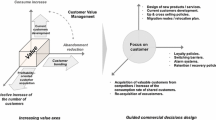Abstract
Large companies interact with their customers to provide a variety of services to them. Customer service is one of the key differentiators for companies. The ability to predict if a customer will leave in order to intervene at the right time can be essential for pre-empting problems and providing high level of customer service. The problem becomes more complex as customer behaviour data is sequential and can be very diverse. We are presenting an efficient sequential forecasting methodology that can cope with the diversity of the customer behaviour data. Our approach uses a combination of KNN (K nearest neighbour) and sequence alignment. Temporal categorical features of the extracted data is exploited to predict churn by using sequence alignment technique. We address the diversity aspect of the data by considering subsets of similar sequences based on KNNs. Via empirical experiments, it can be demonstrated that our model offers better results when compared with original KNNs which implies that it outperforms hidden Markov models (HMMs) because original KNNs and HMMs applied to the same data set are equivalent in terms of performance as reported in another paper.
Access this chapter
Tax calculation will be finalised at checkout
Purchases are for personal use only
Similar content being viewed by others
References
J. Hadden, A. Tiwari, R. Roy, D. Ruta, International Journal of Intelligent Technology 1(1), 104 (2006)
C. Archaux, H. Laanaya, A. Martin, A. Khenchaf, in International Conference on Information & Communication Technologies: from Theory to Applications (ICTTA) (2004), pp. 19–23
M. Eastwood, B. Gabrys, in Proceedings of the KES2009 Conference (Santiago, Chile, 2009)
B. Lariviere, D. Van den Poel, Expert Systems with Applications 29(2), 472 (2005)
A. Lemmens, C. Croux, Journal of Marketing Research 43(2), 276 (2006)
D. Ruta, D. Nauck, B. Azvine, in Intelligent Data Engineering and Automated Learning IDEAL 2006, Lecture Notes in Computer Science, vol. 4224, ed. by E. Corchado, H. Yin, V. Botti, C. Fyfe (Springer, Berlin, 2006), pp. 207–215
C. Wei, I. Chiu, Expert Systems with Applications 23(2), 103 (2002)
Churn Prediction using Complaints Data.
S. Nam, P. Manchanda, P. Chintagunta, Ann Arbor 1001, 48 (2007)
R. Duda, P. Hart, D. Stork, Pattern Classification (Wiley, New York, 2001)
M. Berry, G. Linoff, Data Mining Techniques: for Marketing, Sales, and Customer Relationship Management (Wiley, Newyork, 2004)
M. Waterman, Philosophical Transactions of the Royal Society of London, Series B: Biological Sciences 344, 383 (1994)
S. Needleman, C. Wunsch, Journal of Molecular Biology 48, 443 (1970)
T. Smith, M. Waterman, Journal of Molecular Biology 147, 195 (1981)
Author information
Authors and Affiliations
Corresponding author
Editor information
Editors and Affiliations
Rights and permissions
Copyright information
© 2013 Springer International Publishing Switzerland
About this paper
Cite this paper
Le, M., Nauck, D., Gabrys, B., Martin, T. (2013). KNNs and Sequence Alignment for Churn Prediction. In: Bramer, M., Petridis, M. (eds) Research and Development in Intelligent Systems XXX. SGAI 2013. Springer, Cham. https://doi.org/10.1007/978-3-319-02621-3_21
Download citation
DOI: https://doi.org/10.1007/978-3-319-02621-3_21
Published:
Publisher Name: Springer, Cham
Print ISBN: 978-3-319-02620-6
Online ISBN: 978-3-319-02621-3
eBook Packages: Computer ScienceComputer Science (R0)




